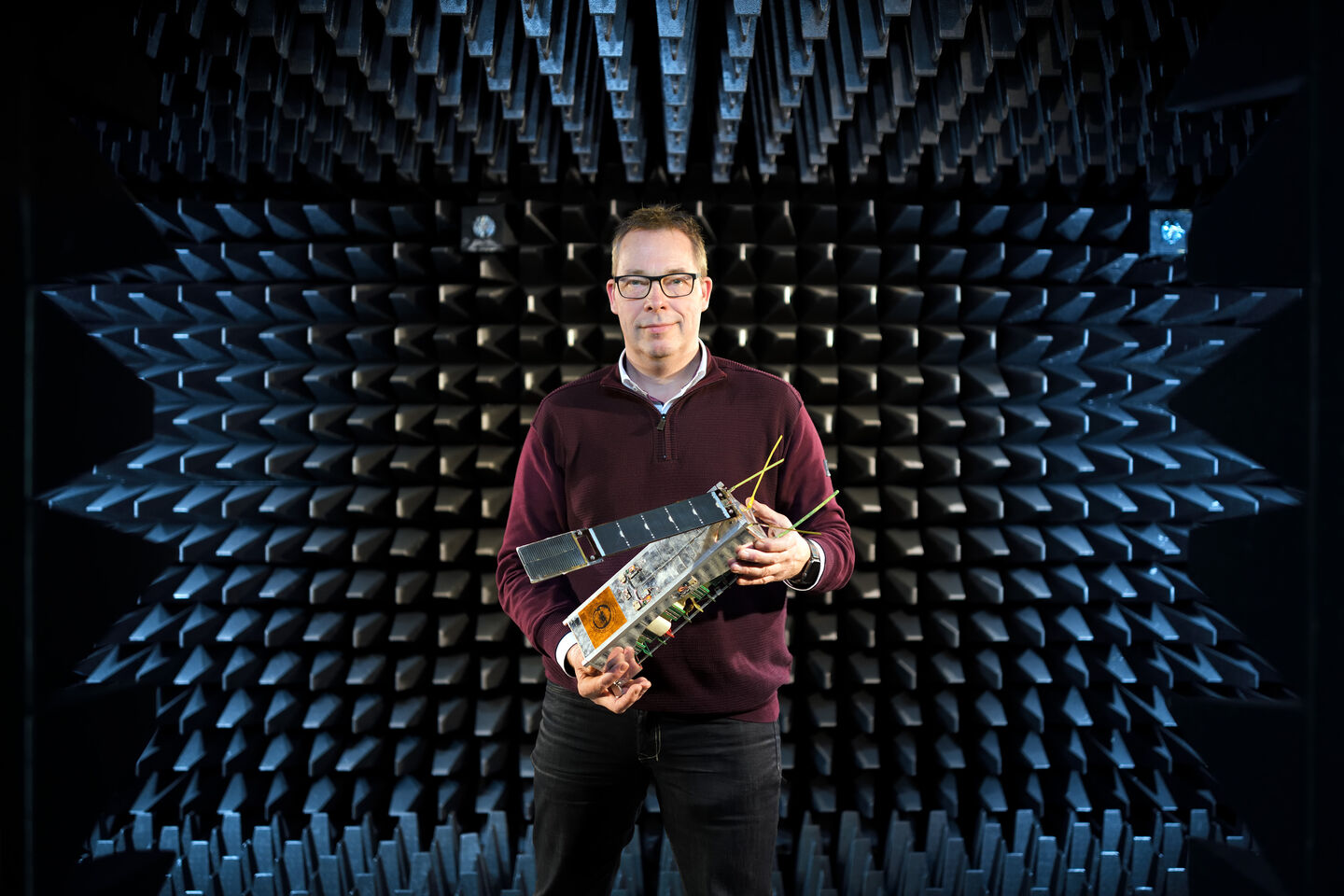
Radio in space
If the freshly appointed TU/e professor Mark Bentum gets to decide, we will soon be charting the earliest epoch of the universe and planets that circle distant stars. Orbiting the moon and fitted with retractable antennas, a swarm of hundreds of nano-satellites will search for radio signals that never reach the earth. The first trial satellite will be launched this year as part of a Sino-Dutch space mission.
The Big Bang echoes even today through the expanding universe. Not in the form of sound – that would be pushing the metaphor – but as endlessly extended electromagnetic waves, which millions of years later have found their way onto the radio spectrum. This has brought them to the attention of Mark Bentum, connected to TU/e since last September as professor of Radio Science at the Department of Electrical Engineering.
“About the initial period of the universe, up to roughly four hundred million years after the Big Bang, we still know very little,” Bentum explains. “What we do know is that the universe must have been immensely hot, and a great deal of heat radiation was released when particles collided with each other. Today we can see this radiation in the form of radio waves because as the universe has expanded the waves have been massively stretched.”
Radio waves like these, remnants of the infancy of the universe, are referred to using the term 'cosmic microwave background radiation', or CMB for short. Most of this radiation now has a wavelength measuring millimeters. However, the universe also contains electromagnetic radiation dating from a period a short while later when the universe had cooled off enough for the first hydrogen and helium atoms to form; this electromagnetic radiation has a much longer wave length.
The primary source of this radiation is a process called the spin flip within the hydrogen atom whereby radiation with a wave length of 21 centimeters is emitted. It is this hydrogen radiation that Bentum is keen to study in order to learn more about the period between the coming into being of the first atoms and the moment when the first stars were formed roughly four hundred million years after the Big Bang. “This period, when there was nothing in the universe but hydrogen and helium, is also known as the Dark Ages of cosmology,” says Bentum.
“Using this radiation from hydrogen, at 1.4 gigahertz, in combination with telescopes like those at Dwingeloo and Westerbork you can do things like chart distant galaxies,” he continues. “The farther these galaxies are from us, the longer the expansion of the universe has been going on, and the lower the observed frequency. We call this stretching phenomenon 'redshift'.”
Owing to this phenomenon, radiation coming from the farthest – and thus oldest – galaxies may reach telescopes on earth only just or not at all, the professor explains. “The hydrogen radiation from the Dark Ages has been so elongated by the redshift, to as much as a few dozen meters, that it fails to penetrate the ionosphere - the topmost layer of the atmosphere.”
Flipside
This reflection of cosmic hydrogen radiation by the ionosphere is the flipside of a phenomenon of which we make grateful use here on earth; it is this effect that makes it possible to transmit radio broadcasts over much of the earth's surface. The frequency band that interests radio cosmologists lies roughly between the AM and FM radio frequencies, namely around 10 megahertz.
“Research into cosmic radio waves below about 30 megahertz is practically impossible on earth; not only due to the protective effect of the ionosphere, but also due to the disruptive impact of radio signals generated by humans,” says Bentum.
OLFAR
Drenthe-born Mark Bentum has always been fascinated by the combination of radio engineering and astronomy. Since gaining his doctorate in electrical engineering at the University of Twente he has worked at the Netherlands Institute for Radio Astronomy (ASTRON), in the village of Dwingeloo in the province of Drenthe. When he took up an additional post at his alma mater Twente, he set up various astronomy research projects there. This got him involved in the Orbiting Low Frequency Array project (OLFAR), which aimed to sidestep the disruptive effect of the ionosphere by putting satellites carrying antennas into space.
As a spinoff of this project there will be a single antenna on the Chinese Chang’e 4 satellite that will be put into orbit around the moon before the end of this year. “This is pretty much the first time it has been possible to measure from space the low-frequency part of the electromagnetic spectrum.” For the high-frequency part, gamma and X-ray radiation, which are also unable to penetrate the atmosphere, there have been instruments in space for some time now. Even for visible light, there are satellite telescopes; the most well-known is undoubtedly the Hubble telescope, which makes fabulous pictures of things like galaxies using visible and infrared light.
The only previous measurements taken in space of the low radio frequencies were taken by a single antenna on a NASA satellite orbiting the moon, Bentum explains. “That was back in the 1970s, and those measurements provided little detail. The only conclusion that could be drawn was that even at these frequencies the cosmos has a certain structure. And that better measurements could therefore prove interesting.”
Now that he spends three days a week as a professor in Eindhoven – he still works two days a week for ASTRON – Bentum is determined to resume this mission. At the European Space Agency (ESA) in Noordwijk he presented a plan in December for the Deep Space Gateway, the possible successor of the International Space Station. “We are very keen to place four antennas on the Deep Space Gateway. In contrast to using a single antenna this would enable us to produce an actual map of the radiation sources.” On this proposal he collaborated with, among others, the renowned astronomer Heino Falcke of the Radboud University Nijmegen, in 2011 the recipient of the Spinoza Prize, and space travel experts at TU Delft.
A swarm of antennas
The antennas on the Deep Space Gateway, however, would be merely a step on the way to the ultimate dream: a swarm of hundreds of satellite antennas spread over an area of hundreds of kilometers, all capable of communicating with each other and thus creating a gigantic radio telescope.
“Look,” says Bentum, while he places on his desk what looks like a computer case that's been worked open. “This is what we call a nano-satellite. It's an exact copy of Delfi-C3 produced by TU Delft, which was put into a low-lying orbit around the earth in 2008. It consists of a stack of three cubes measuring 10 x 10 x 10 centimeter. We will probably need six cubes, that's a C6, because we need more electronics, as well as power, and thus larger solar panels.”
Five meters long
Nano-satellites like these must be equipped with three antennas arranged in three mutually perpendicular positions. “As a set of axes, as it were,” the professor explains. Sticking out from the C3 in his hands are pieces of metal measuring tape. For the sake of convenience these have been cut short, explains Bentum. “They weren't so long anyway because they were only intended to communicate with the earth. But to pick up the signal from the Dark Ages, you need antennas 5 meters long.”
It goes without saying that these great long things cannot be launched in their extended position; they can only take that form in space. So a major challenge is to find the best way to roll up the antennas as small as possible. “Metal measuring tape is not a bad starting point. Though we will probably want to use a lightweight plastic containing a copper or gold wire, or perhaps covered with a conductive spray coating. It is useful that we can test the prototypes here in the TU/e's anechoic room.”
So suppose that super swarm is up there, floating in an orbit around the moon. How can you make sure you receive the relevant measurement data back on earth? “You should bear in mind that the signal we're searching for is actually a kind of noise. This means that you have virtually no scope for compressing it before transmitting it to earth. It makes sense to do some of the data analysis while it is still in space, so that ultimately you need send only the correlated data, which is amassed using all the various antennas. But that requires that all the satellites can communicate with each other. We are keen to find out whether that can be done optically; i.e. by means of light instead of using radio signals. Then we could send much more data.”
Nobel Prize
If it were indeed possible to chart the structure of the earliest universe using the swarm of satellite antennas, Bentum believes this would be ‘Nobel Prize-level science’. And if not, the attempt would give rise to at least one more claim to fame; an extraterrestrial antenna system like this should make it possible to detect 'exoplanets' – planets that orbit a star other than our own sun.
“If a planet has a magnetic field, as the earth does, it may well be a place where radio waves are generated by the interaction with charged particles that are emitted by their star, much like our solar wind,” the ambitious professor explains. “Jupiter emits a good deal of radio waves of this kind; thanks to their relatively high frequency you can even observe them from earth. Similar signals from Neptune and Uranus have been detected by the space probe Voyager. So radio astronomy in space should also be a good method of finding direct evidence of new exoplanets!”

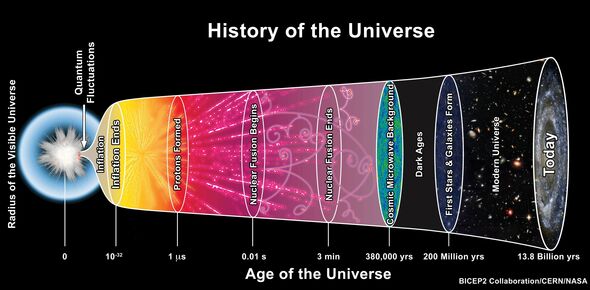
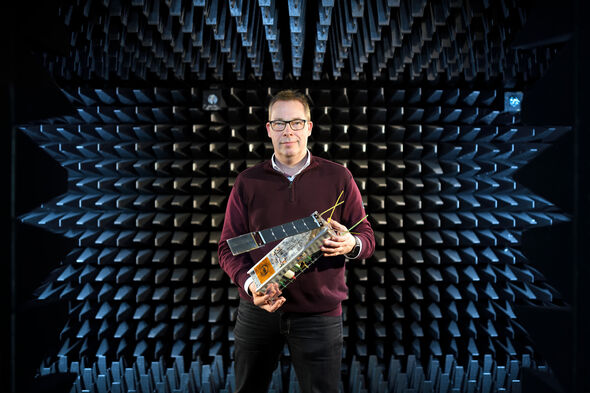
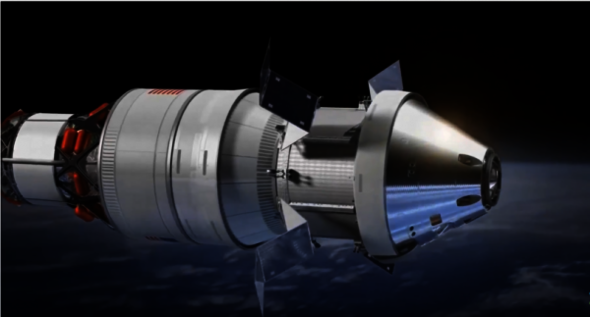
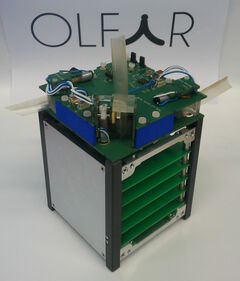
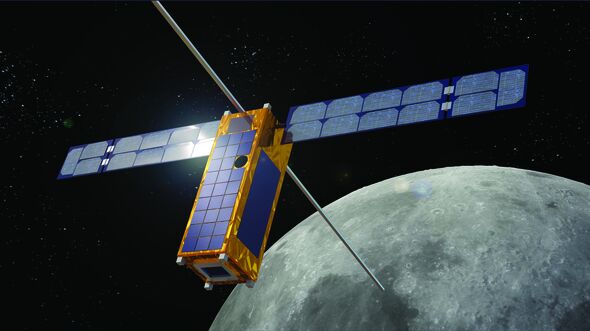
Discussion